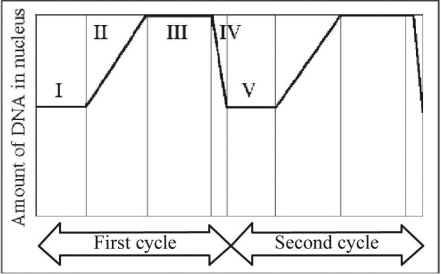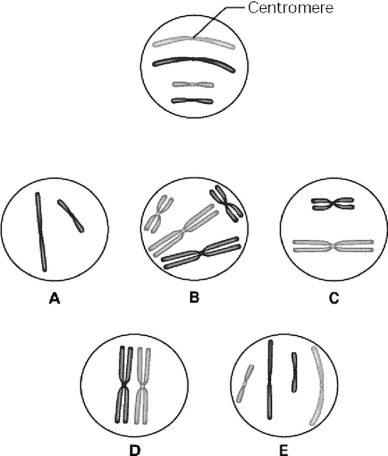A) As cells become more numerous, they begin to squeeze against each other, restricting their size and ability to produce growth factors.
B) As cells become more numerous, the protein kinases they produce begin to compete with each other, such that the proteins produced by one cell essentially cancel those produced by its neighbor.
C) As cells become more numerous, the cell surface proteins of adjacent cells bind to each other and send signals that inhibit cell division.
D) As cells become more numerous, the level of waste products increases, eventually slowing down metabolism.
F) None of the above
Correct Answer

verified
Correct Answer
verified
Multiple Choice
Which of the following is true concerning cancer cells?
A) They exhibit density-dependent inhibition when growing in culture.
B) They must be attached to a substrate to divide in culture.
C) They evade the normal controls that trigger programmed cell death.
D) They stop dividing in culture when growth factors are depleted.
F) B) and C)
Correct Answer

verified
Correct Answer
verified
Multiple Choice
Diatoms and some yeasts are unicellular eukaryotes that have mechanisms of nuclear division that may resemble intermediate steps in the evolution of mitosis. Which of the following is a characteristic feature of nuclear division in these organisms?
A) They have circular chromosomes that are segregated by attachment to the plasma membrane.
B) They have circular chromosomes that are segregated by attachment to spindle microtubules.
C) Chromosomes are not condensed during nuclear division.
D) The nuclear envelope remains intact during division.
F) A) and C)
Correct Answer

verified
Correct Answer
verified
Multiple Choice
Where are the motor proteins that move chromosomes toward the poles of the mitotic spindle located?
A) on the centrioles
B) in the centrosomes
C) on the kinetochores
D) along the length of kinetochore microtubules
F) B) and C)
Correct Answer

verified
Correct Answer
verified
Multiple Choice
The cell cycle is regulated at the molecular level by a set of proteins known as
A) ATPases.
B) separase proteins.
C) cohesins.
D) cyclins.
F) A) and B)
Correct Answer

verified
Correct Answer
verified
Multiple Choice
The beginning of anaphase is indicated by which of the following?
A) loss of kinetochores from sister chromatids
B) enzymatic cleavage of cohesin
C) joining of the sister chromatids to each other by cohesin
D) polymerization of spindle microtubules
F) A) and C)
Correct Answer

verified
Correct Answer
verified
Multiple Choice
 Figure 9.3
-In Figure 9.3, which number represents the point in the cell cycle during which the chromosomes are replicated?
Figure 9.3
-In Figure 9.3, which number represents the point in the cell cycle during which the chromosomes are replicated?
A) I
B) II
C) III
D) IV
E) V
G) C) and D)
Correct Answer

verified
Correct Answer
verified
Multiple Choice
What is a cleavage furrow?
A) a ring of vesicles forming a cell plate
B) an indentation between daughter prokaryotic cells
C) a groove in the plasma membrane between daughter nuclei
D) the metaphase plate where chromosomes attach to the spindle
F) C) and D)
Correct Answer

verified
Correct Answer
verified
Multiple Choice
Besides the ability of some cancer cells to divide uncontrollably, what else could logically result in a tumor?
A) enhanced anchorage dependence
B) changes in the order of cell cycle stages
C) lack of appropriate cell death
D) inability to form spindles
F) A) and B)
Correct Answer

verified
Correct Answer
verified
Multiple Choice
A group of cells is assayed for DNA content immediately following mitosis and is found to have an average of 8 picograms of DNA per nucleus. How many picograms would be found at the end of S and the end of G2?
A) 8; 8
B) 8; 16
C) 16; 8
D) 16; 16
E) 12; 16
G) A) and D)
Correct Answer

verified
Correct Answer
verified
Multiple Choice
A cell in G2 of the cell division cycle contains 20 chromatids. How many centromeres are present in this cell?
A) 10
B) 20
C) 30
D) 40
E) 80
G) A) and B)
Correct Answer

verified
Correct Answer
verified
Multiple Choice
 Figure 9.3
-In Figure 9.3, which of the numbered regions would contain cells at metaphase?
Figure 9.3
-In Figure 9.3, which of the numbered regions would contain cells at metaphase?
A) I and IV
B) II only
C) III only
D) IV only
E) V only
G) D) and E)
Correct Answer

verified
Correct Answer
verified
Multiple Choice
Which of the following are primarily responsible for cytokinesis in plant cells but not in animal cells?
A) spot desmosomes
B) tubulin and dynein
C) actin and myosin
D) centrioles and centromeres
E) Golgi-derived vesicles
G) B) and E)
Correct Answer

verified
Correct Answer
verified
Multiple Choice
Cells from advanced malignant tumors frequently have very abnormal chromosomes as well as an abnormal number of chromosomes. What might explain the association between malignant tumors and chromosomal abnormalities?
A) Cancer cells replicate chromosomes multiple times per cell cycle.
B) Cancer cells are no longer anchorage dependent.
C) Cell cycle checkpoints are not in place to stop cells with chromosome abnormalities.
D) Cells with abnormal chromosomes have increased metabolism.
F) B) and C)
Correct Answer

verified
Correct Answer
verified
Multiple Choice
 Figure 9.3
-In Figure 9.3, G1 is represented by which numbered parts of the cycle?
Figure 9.3
-In Figure 9.3, G1 is represented by which numbered parts of the cycle?
A) I or V
B) II or IV
C) III only
D) IV only
E) V only
G) D) and E)
Correct Answer

verified
Correct Answer
verified
Multiple Choice
 Figure 9.3
-In Figure 9.3, DNA synthesis is represented by which numbered parts of the cycle?
Figure 9.3
-In Figure 9.3, DNA synthesis is represented by which numbered parts of the cycle?
A) I
B) II
C) III
D) IV
E) V
G) A) and D)
Correct Answer

verified
Correct Answer
verified
Multiple Choice
Most animal cells exhibit anchorage dependence, which means that in order to divide
A) all chromosomes must be attached to spindle microtubules.
B) nonkinetochore microtubules from opposite poles must overlap and be attached by motor proteins.
C) cell-surface phospholipids must be attached to those of adjoining cells.
D) cells must be attached to a substrate or extracellular matrix of a tissue.
F) A) and C)
Correct Answer

verified
Correct Answer
verified
Multiple Choice
Please use the following information to answer the question(s) below.
The unlettered circle at the top of Figure 9.1 shows a diploid nucleus with four chromosomes that have not yet replicated. There are two pairs of homologous chromosomes, one long and the other short. One haploid set is black, and the other is gray. The circles labeled A-E show various combinations of these chromosomes.  Figure 9.1
-Which image displays the chromosomal composition of one daughter nucleus at telophase of mitosis?
Figure 9.1
-Which image displays the chromosomal composition of one daughter nucleus at telophase of mitosis?
A) A
B) B
C) C
D) D
E) E
G) A) and B)
Correct Answer

verified
Correct Answer
verified
Multiple Choice
Please use the following information to answer the question(s) below. Nucleotides can be radiolabeled before they are incorporated into newly forming DNA and can therefore be assayed to track their incorporation. In a set of experiments, a student-faculty research team introduced labeled T nucleotides into the culture of dividing human cells at specific times. -The research team used the setup to study the incorporation of labeled nucleotides into a culture of lymphocytes and found that the lymphocytes incorporated the labeled nucleotide at a significantly higher level after a pathogen was introduced into the culture. They concluded that
A) the presence of the pathogen made the experiment too contaminated to trust the results.
B) their tissue culture methods needed to be relearned.
C) infection causes lymphocytes to divide more rapidly.
D) infection causes cell cultures in general to reproduce more rapidly.
E) infection causes lymphocyte cultures to skip some parts of the cell cycle.
G) B) and E)
Correct Answer

verified
Correct Answer
verified
Multiple Choice
Researchers began a study of a cultured cell line. Their preliminary observations showed them that the cell line did not exhibit either density-dependent inhibition or anchorage dependence. What could they conclude right away?
A) The cells originated in the nervous system.
B) The cells show characteristics of tumors.
C) The cells have altered series of cell cycle phases.
D) The cells were originally derived from an elderly organism.
F) C) and D)
Correct Answer

verified
Correct Answer
verified
Showing 21 - 40 of 56
Related Exams